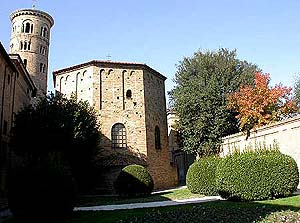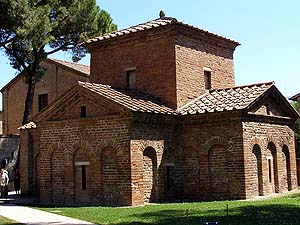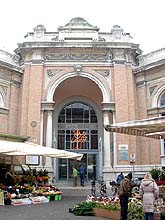
Ravena Top Ten
This originally had ten things to do in Ravenna, Italy. Since there are many more things to see and do in Ravenna, I have changed it to ten categories of things to do in Ravenna.
Eight of the oldest buildings in Ravenna, which all contain ancient mosaics, have been included in the World Heritage List. These are: the Mausoleum of Galla Placida, the Church of Saint Vitale, the Neonian Baptistry, the Archiepiscopal Chapel, the Basilica of Sant'Apollinaire Nuovo, the Arian Baptistry, the Mausoleum of Theodoric and the Basilica of Sant'Apollinaire in Classe.
Ravenna became the capital of the Western Roman Empire in the 5th century, and the Romans began creating mosaic art here at that time.
After the fall of the Roman Empire, the Ostrogoths, under King Theorodic, ruled Ravenna until the Byzantine emperor Justinian I took Ravenna.
Since the mosaic tradition continued throughout all of this, the mosaics here are a mixture of Roman, Ostrogoth and Byzantine art, some from as early as the 6th century.
Il Papavero Guide turistiche di Ravenna
Welcome to Ravenna
Ravenna Tourist Attractions from Planetware.com
Sacred Destinations: Ravenna Timeline
Churches
Basilica di Sant'Apollinare Nuovo
 Sacred Destinations: Sant'Apollinare Nuovo
Sacred Destinations: Sant'Apollinare Nuovo
This basilica is named for the patron saint of Ravenna, Saint Apollinaris.
The church was originally built around 500 AD by Theodoric as an Arian church, and many of the mosaics are from this period.
There were mosaics at the west end of the nave that depicted Theodoric and his court.
But these were blacked out (except for one "floating" hand) and covered with curtains around 560 when the church was converted and dedicated to Saint Martin.
Most of the rest of the mosaics date from the Catholic period around 560 AD.
In the 9th century, the basilica was rededicated to Saint Apollinaris when his bones were moved here from the nearby Sant'Apollinare in Classe, which has some amazing mosaics of its own.
This church is actually older than Sant'Apollinare in Classe.
The "Nuovo" in its name was added to distinguish it from an older church that no longer exists.
Basilica Giovanni Battista
 Basilica Giovanni Battista
Basilica Giovanni Battista
This church contains a beautiful mosaic Nativity scene.
The Church of Saint Francis

The Church of Saint Francis has the earliest example in Italy of the decorative use of majolica.
This church also has impressive capitals in its nave and a fine apse mosaic depicting the Transfiguration of Christ
In 1321, Dante died in Ravenna at the age of 56.
His funeral was held at the Basilica of St. Francis in Ravenna and his body was buried in the church.
He was moved to the neoclassical Tomb of Dante next to the church in 1730.
You can see primitive floor mosaics under water in the church.
Baptistries
Neonian Baptistery (Orthodox Baptistery)
 Sacred Destinations: Neonian Baptistery
Sacred Destinations: Neonian Baptistery
The Neonian Baptistery is the oldest monument in Ravenna, built on an octagonal floor plan in the 5th century.
It was converted from an old Roman bath-house and the mosaics were added to the dome in the second half of the 5th century.
The central part of the mosaics depicts the Baptism of Christ by John the Baptist in the River Jordan, parts of which have been restored in the 18th century.
In the 19th century, a Roman artisan named Felice Kibel, charged with restoring the mosaics, added the dish that St. John is using to pour the water.
Arian Baptistery
 Sacred Destinations: Arian Baptistery
Sacred Destinations: Arian Baptistery
The Arian Baptistery is located next to the old Arian cathedral of Santo Spirito.
It was built by Theodoric at the end of the 5th century with an octagonal floor plan, not long after the orthodox baptistery (the Neonian Baptistery) was built.
The most notable mosaic is on the dome, with a depiction of the baptism of Jesus in the river Jordan.
This is similar to the mosaic in the orthodox baptistery but it reflects aspects of the Arian sect that differ from the orthodox Catholic beliefs.
Tombs
Mausoleum of Galla Placidia
 Sacred Destinations: Mausoleum of Galla Placidia
Sacred Destinations: Mausoleum of Galla Placidia
This building was probably commissioned by the Roman empress Galla Placidia probably as an oratory rather than a mausoleum.
It was built around 430 AD, and she was never buried here.
It was described by UNESCO as"the earliest and best preserved of all mosaic monuments."
Some of the more notable mosaics to note here are:
- the vault, which features a lovely mosaic of a starry night sky
- an early depiction of Christ as the Good Shepherd, located over the entrance on the north side
- and on the south side, a mosaic which is probably a depiction of St. Lawrence, who was martyred on a hot iron grill
Tomb of Theodoric
 The Mausoleum of Theodoric
The Mausoleum of Theodoric
The Tomb of Theodoric was built about 520, probably on the order of Theodoric himself.
This is a monumental two-story rotunda built in square blocks of Istrian limestone and roofed with a single huge block 11m/12yd in diameter.
The tomb is reminiscent of Syrian rather than Roman models.
The ornamentation shows clear Germanic influence.
The lower floor is a barrel-vaulted chamber in the form of a Greek cross, on the upper floor is an antique porphyry sarcophagus.
Tomb of Dante Alighieri
 Sacred Destinations: Dante's Tomb (Tomba di Dante)
Sacred Destinations: Dante's Tomb (Tomba di Dante)
Dante was exiled from his beloved hometown of Florence and lived in several places, including Venice, before he died in Ravenna in 1321.
Via Dante Alighieri, Ravenna, Italy
Telephone: 0544-30252
Museums
Museo d'Arte della Citté di Ravenna
 MAR — Museo d'Arte della Citté di Ravenna
MAR — Museo d'Arte della Citté di Ravenna
via di Roma, 13 Ravenna
Telephone: 39 0544 482477/482356
Markets
Mercato Coperto (Covered Market)
 Piazza Andrea Costa, Ravenna 48100
Piazza Andrea Costa, Ravenna 48100
Science
Planetarium

The planetarium in Ravenna is decorated with a huge sundial and astronomical charts.
Culture
Leisure
Civic Architecture
Clock Tower

In the center of Ravenna is the Piazza del Popolo, with the Palazzo Comunale (Town Hall, 1681).
In front of the Town Hall are two granite columns erected by the Venetians in 1483.
In the square stands the Palazzo Veneziano, a portico of eight granite columns, with Theodoric's monogram on four of the capitals.
Nature
